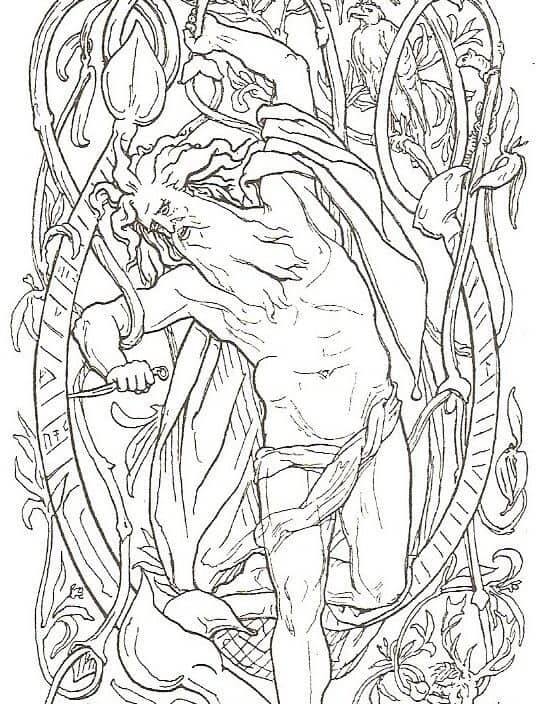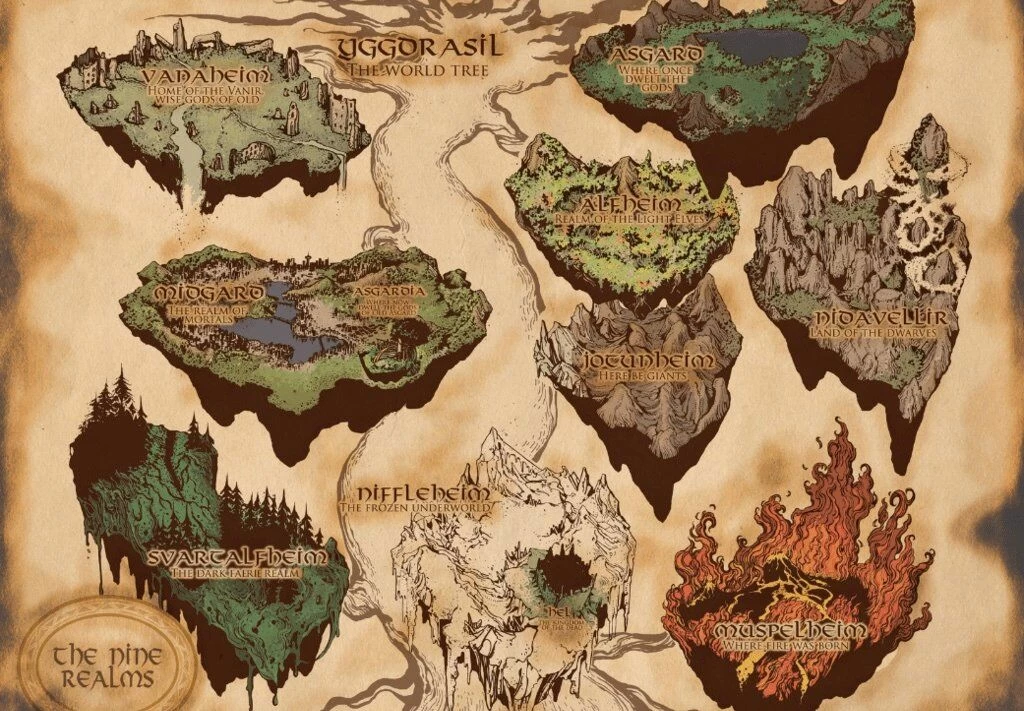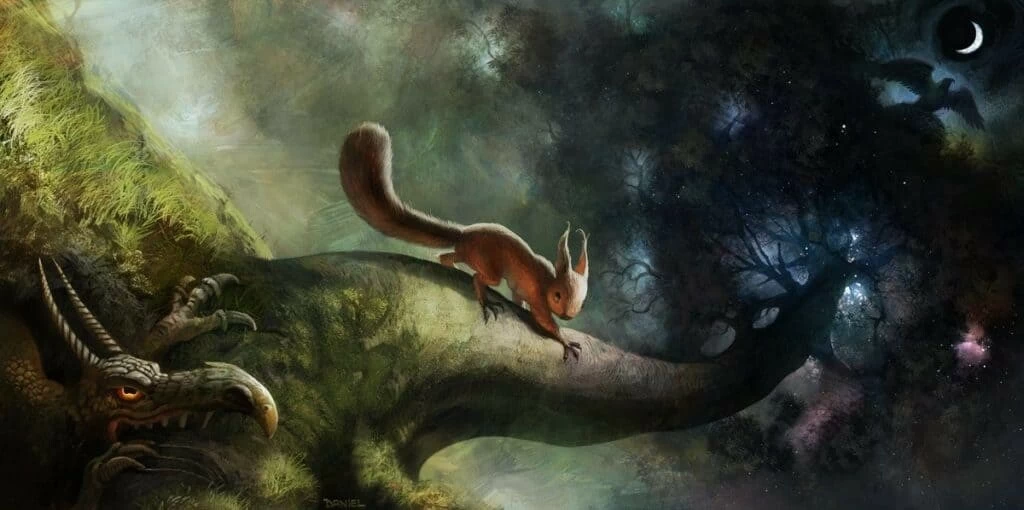In Norse mythology Yggdrasil is the name of an enormous glistening ash tree that cradles the nine realms of the cosmos within its branches and roots, thereby connecting all things. The holy tree is evergreen and is covered in moist white loam. It supports all of creation – gods, giants, man, and beasts – some of which eat directly from the branches and roots of the tree. Yggdrasil is also called the World Tree or Tree of Life because it contains all the worlds and represents the cycle of birth, growth, death, and rebirth.

The true principles and meanings of the tree, as well as all Old Norse religion and myths, are profound and complex, yet strikingly beautiful. The full meaning of Yggdrasil cannot be covered in one article, therefore, this serves as an introduction to the basic concepts of the world tree of Norse mythology.
Sources of Norse Mythology and Cosmology
Norse mythology, primarily that of pre-Christian references, is a rich source of history of the proto-Germanic and Old Norse cultures. It reveals the interconnectedness in which the people saw the world of gods, humans, and nature, and shows us the depth of their religion and cosmological principles. The Yggdrasil tree is only one small, yet very important, glimpse of the vastness of Norse mythology.
The Poetic Edda
The two main sources of Norse poems and stories are called the Eddas. They both contain information about the tree of life. The first is the Poetic Edda, which was compiled in the 13th century of older Norse and proto-Germanic sources and beliefs that endured the Christianization of Iceland in 1000 AD. It is also called the Elder Edda. Although there are fewer details about the Norse world tree in the Poetic Edda, many scholars consider this compilation to be much more historically accurate than some other sources.
The Prose Edda
The second source, the Prose Edda, was written in the 13th century by the Icelandic Christian politician and historian, Snorri Sturluson. Some scholars indicate that much of the Prose Edda is embellished, based on the personal interpretations and Christian influences of its author. Although this version expands the description of the world tree with much more descriptive and intriguing details, it is considered less true to pre-Christian pagan Norse mythology.
[blockquote align=”none” author=”Poetic Edda, translation from the poem, Völuspá”]An ash I know stands
Its name is Yggdrasil,
A noble tree bathed in clear moisture.
From there comes the dew that falls in the valleys.
Standing evergreen above Urd’s Well.[/blockquote]
Etymology of the Word Yggdrasil
Yggdrasil pronunciation is ig-druh-sil. Scholars debate the origin of the word, with the most common interpretation being Odin’s horse. Yggr, “The Terrible One,” is another name for Odin (he has many names), the chief of the Norse gods. Drasill means horse. The term Odin’s horse is symbolic for gallows, which pertains to the Norse world tree. The tree served as Odin’s gallows in the poem, Odin’s Rune Song, of the Poetic Edda, in which Odin hung himself on the tree for nine days. The following is an interpretation of the mythological story that links Odin’s gallows to the holy tree.
The Myth of Odin and the Runes
Odin desired the power to control destiny. But in order to have that control he needed to be able to see and decipher the magic runes, which are a system of symbols that convey wisdom, intention, and power. The runes had the ability to spread intentions across the cosmos through their meanings.
Only the Norns, the three maidens of fate, who lived within the Well of Urd at the bottom of the Norse world tree, understood the runes. The Norns were the controllers of destiny. In order to manifest their desires for all of creation, they would carve the runes into the sacred tree’s trunk. Through the runes, the meanings and intentions of the Norns would travel along the branches and roots of the tree to each of the nine worlds.
You May Also Like: The Kensington Runestone
To gain the ability to wield the immense power of the runes, Odin had to sacrifice himself. He needed to be worthy of such potent and frightful wisdom. So he stabbed himself and then hung himself from the World Tree for nine days. This was a sacrifice of himself to himself, and only then was he able to obtain the meaning and power of the runes.

Wounded i hung on a wind-swept gallows
For nine long nights, pierced by a spear,
Pledged to Odin, offered myself to myself.
The wisest know not from whence spring
The roots of that ancient tree.
They gave me no bread,
They gave me no mead,
I looked down;
With a loud cry i took up runes;
From Odin’s Rune Song
Nine Worlds of Norse Mythology
Within the branches and roots of the Norse tree, nine worlds or realms of the cosmos exist. There is no concrete description of the configuration of the Norse worlds in the Eddas, although many people have attempted to make one up. There are also varying interpretations and names. Additionally, much of the current information we have was added later in the Prose Edda, which is where some of the following descriptions have been acquired.

Primordial Worlds of Niflheim and Muspelheim
The first worlds that existed before the existence of any other matter were Niflheim and Muspelheim, the primordial realms of ice and fire. They were separated by Ginnungagap, the yawning void or the abyss. As the fire of Muspelheim and the ice of Niflheim reached out toward each other, the ice began to melt. The result was a steaming soup of creation, and the first being, the giant Ymir, was formed. The icy realm of Niflheim was populated with Frost Giants, while the fiery land of Muspelheim was populated with the eldjötnar or Fire Giants.
Asgard
Asgard is the realm of the Aesir, the Norse pantheon of gods. These include well-known figures as Thor, Odin, and Balder. The world of Asgard sits high in the branches of Yggdrasil. Heroic soldiers who die go to Asgard after death. The best warriors are sent to Valhalla to eat and drink and prepare for battle in Ragnarok, the end of this cycle of the Norse cosmological world.
Midgard
Midgard, or Earth, sits somewhere in the middle of the cosmos under Asgard. It is the home of humans and is the only world that lies within the visible realm. All the other worlds are mostly invisibly, although they interact with the visible dimension occasionally. A burning rainbow bridge called Bifrost or Ásbrú (Aesir’s bridge in Old Norse) connects Midgard to Asgard.
Jotunheim
Jotunheim, also called Utgard, is the land of the Giants, or more accurately from Old Norse, the “devourers.” It is the wilderness that surrounds Midgard and is a place of forests and mountains and harsh landscapes. Utgard means beyond the enclosure. It symbolizes a place or concept of wildness, chaos, disorderliness, and nonconformity. The devourers were powerful beings who always strived for chaos, and will continue to do so through Ragnarok.
Vanaheim
Vanaheim is the home of the Vanir pantheon of gods who represent fertility and wisdom. The Vanir are a different tribe of gods than the Aesir of Asgard. Some suggestions indicate that Vanaheim may be a less orderly and refined world than Asgard, however, any breadth of information about the Vanir and Vanaheim is lacking in existing sources.
Alfheim
Alfheim is the dwelling place of the Light Elves who are brighter than the sun to look upon. It is unclear exactly what the elves are. They may be a type of beneficent demigod creature, perhaps similar to angels in Christianity. Their description in the Prose Edda was possibly influenced by Snorri Sturluson’s Christian beliefs.
Nidavellir
Svartalfheim, or Nidavellir as referenced in older texts, is the land of the dwarves. They live under the ground and are brilliant metal workers who built golden halls.
Hel
Helheim or Hel, the underworld of the dead, contributed to the Christian concept of Hell. Unlike Hell of the Bible, Hel of Old Norse religion was not only reserved for sinners. All people went there, regardless of their morals and actions in their lives. Hel is also the name of the goddess who ruled over the underworld of Hel.
Three Roots and Three Wells
The Norse tree of life has three enormous roots that extend far away. Each of them ends in a different world, and they each draw water from a different source. According to the poem Grímnismál, from the Poetic (Elder) Edda, the three roots end in Hel, Jotunheim, and Midgard.
Well of Urd
However, in the Prose Edda, the first root ends in Asgard in the heavens of the highest branches of the sacred tree. This root draws from a well called Urd, which means origin or past. It is also called the Well of Fate and is guarded by the three Norns, as previously noted. Each day all the gods gather at Urd to hold council.
Well of Mimir
The second root leads to Jotunheim. This root is nourished by Mimisbrunnr, the Well of Wisdom, which is guarded by the giant Mimir. Mimir is the wisest being of all the cosmos, and he drinks from the well each day with the horn Gjoll. In another Norse myth, Odin was thirsty for wisdom, so he went to Mimir to ask to drink from the Well. Mimir agreed, but only with the condition that Odin would sacrifice an eye for the drink. Thus, Odin dug out his own eye and threw it into the well. Then, as agreed, Mimir allowed him one drink of the Well of Wisdom.
Well of Hvergelmir
The third root leads to Niflheim, which means “abode of mist” or “mist home.” It has the oldest well, Hvergelmir, which is the source of eleven rivers. A stag, Eikthyrnir, feasts on the branches of the World Tree, and from his horns flows the water that runs into Hvergelmir, thus feeding all rivers. Within the well of Hvergelmir, there are innumerous snakes. The well is guarded by the dragon or serpent Nidhogg, a terrible creature that gnaws on the root of the tree.
Other Creatures that Dwell in the Tree
In addition to the animals already mentioned, there are other creatures that live in the tree of life. One of them is Ratatosk. He is a spiteful, tale-telling squirrel who carries messages to and from the serpentine dragon, Nidhogg. Another is the eagle who lives in the top branches of the World Tree. Nidhogg and the eagle loathe each other, and the messages carried back and forth by Ratatosk consist of insults. Dvalinn, Duraþrór, Duneyrr, and Dáinn are four stags that bound along the branches and eat the tree’s buds. They represent the four winds. Additionally, the goat, Heidrun, lives in Valhalla. Instead of milk flowing from her udders, she produces an endless supply of mead for the warriors.

In the poem Grímnismál, Odin says that the sacred ash, “suffers agony more than men know,” because of the animals that chew the roots and branches of the sacred tree.
Ragnarok
Destruction of the World
The end of the current Norse cosmic cycle that some people mistake as the end of all time is called Ragnarok. The cosmos will end, only to be reborn again. However, during Ragnarok, there will be total and utter chaos. Everyone will be at war, and none will show mercy. Giants, gods, men, and creatures will all be at battle, and it will be a time of deep darkness and despair. Yggdrasil will “shake and groan,” and everything and everyone will be frightened. Nearly all beings and worlds will perish when the Giants succeed in destroying the cosmos.
The New Cosmos
Only two humans, Lif and Lifthrasir will survive by hiding themselves deep within Yggdrasil tree in Hodmimir’s Wood (this may be synonymous with the tree itself). Then, once the fire and chaos have died down, they will bear offspring to begin the new cycle of existence. A few gods will survive. Worlds will be reborn and even the Sun will give birth to a new star. A new cosmos of peace and tranquility without a hint of evil or despair will reign.
Related: Important Norse Symbols and Their Meaning
Though no source explicitly reveals what happens to the sacred tree after Ragnarok, if two humans survive by hiding within it, one can infer that it too survives. After all, the sources say that it is forever green, and through its tree trunk and branches, it conveys the destiny of the cosmos. It must endure. With interpretive liberty, one may view the Norse tree of life as the vast container and observer of all of creation. Yet it is the indestructible creator and is one with the cosmos, as it is one with the supreme and omnipresent Odin. The world tree Yggdrasil will perpetuate the cycle of birth, growth, death, and rebirth for all of eternity.
Additional references:
The New Pagan 2
Viking Mythology
Theo Society